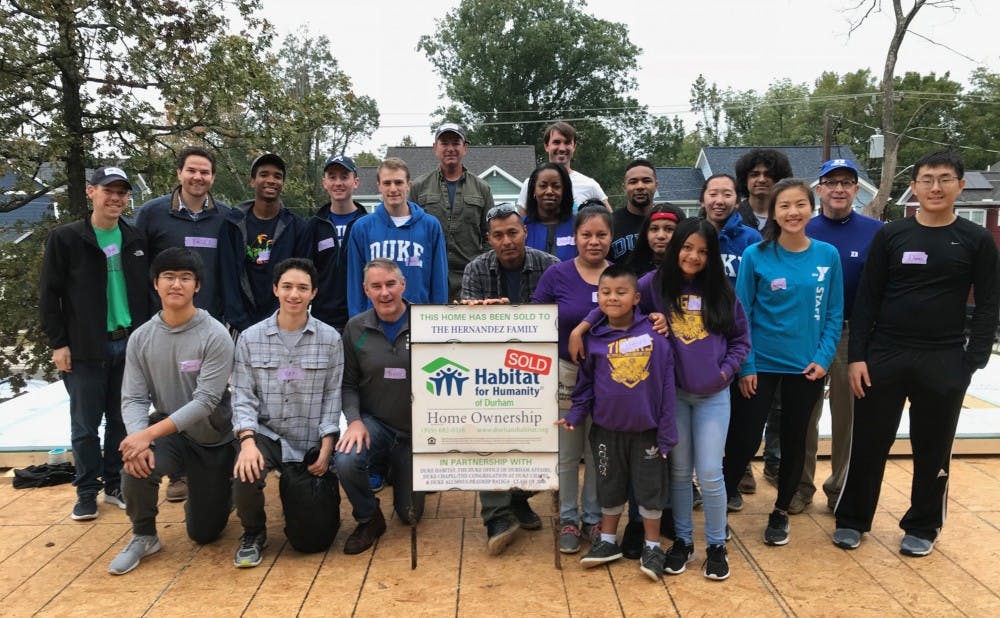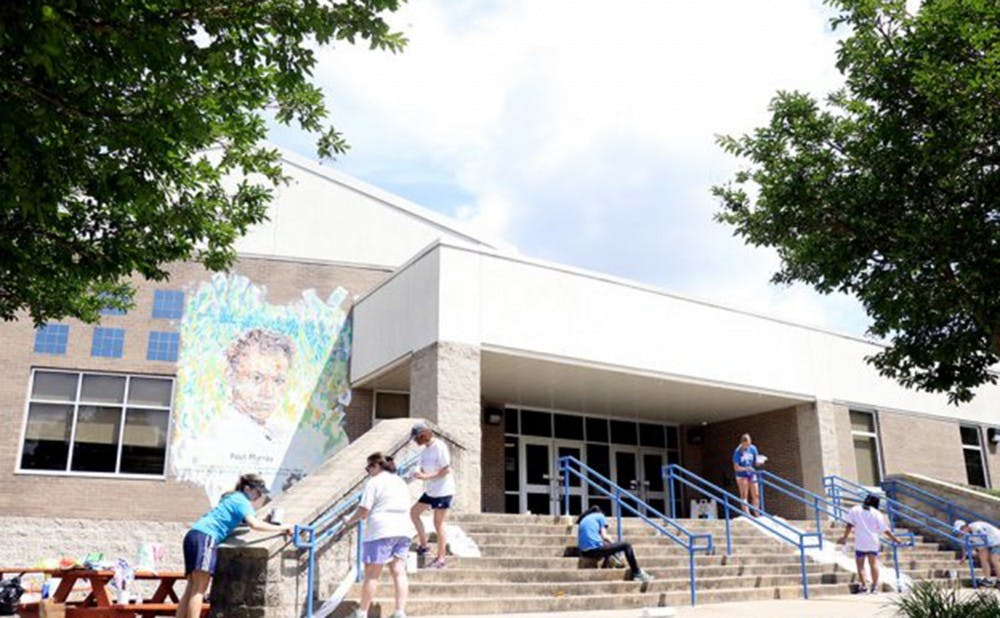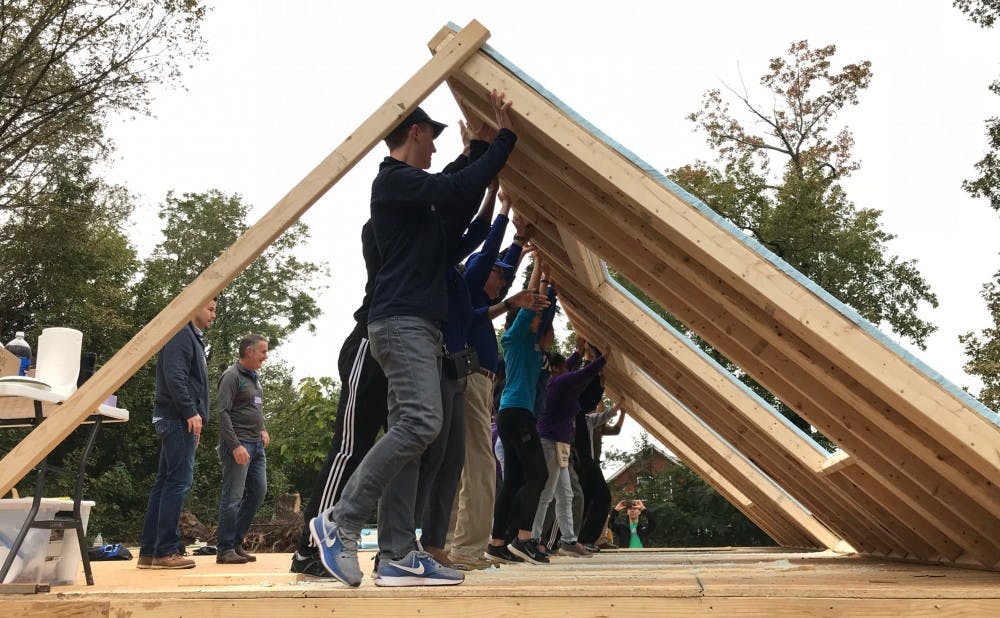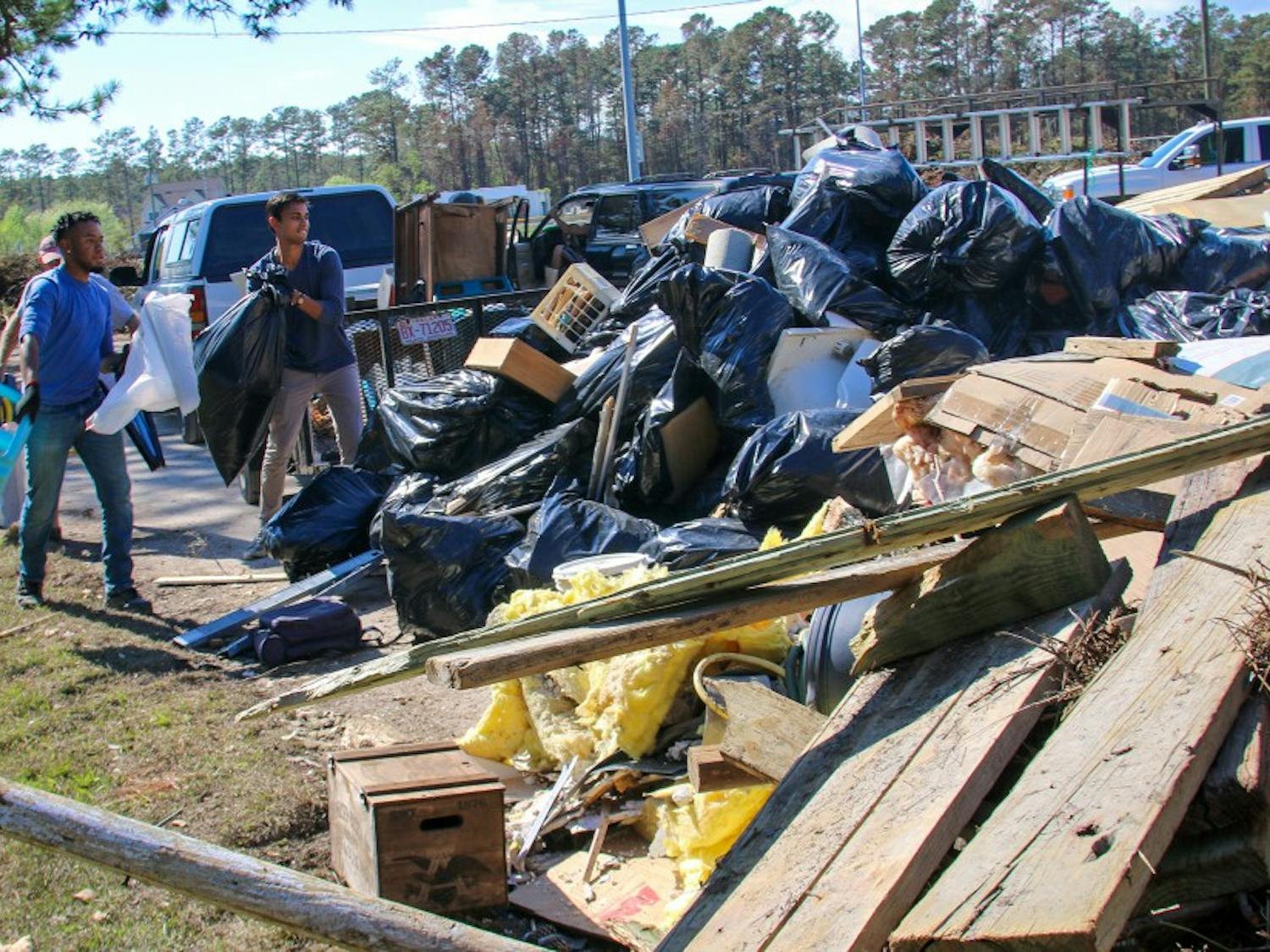In the 1990s, Durham’s tobacco and textile industry was receding, the economy was declining and crime was increasing. At the same time, Duke University was on the rise.
At the intersection of highway I-40 and I-85, Durham became the drug distribution capital of state, said John Burness, who was Duke's senior vice president for government relations and public affairs and led the formation of the Duke-Durham Neighborhood Partnership. And as the town’s main source of income and jobs was disappearing, the newly-inaugurated president Nannerl Keohane recognized Duke’s growing presence and importance to Durham.
Sam Miglarese, director of the Duke-Durham Neighborhood Partnership, explained that the University and Health System became the only existing corporate bodies in Durham. The University was and is the largest private employer in the city and largest employer by dollar volume. However, Burness said the limited corporate presence meant that no one took ownership of the city's problems, so people turned to Duke.
Separate from the city
Those inside and outside the University regarded Duke as separate from Durham, Burness said. Duke was an insular place, where students rarely ventured beyond the University walls and were not engaged in the life of Durham. Shops and restaurants downtown would close by 5 p.m. and were viewed as crime-ridden.
Miglarese said that Durham residents felt Duke was solely focused on its own agenda of becoming a leader in research, teaching and scholarship. Duke’s interactions with the community were disjoint, unfocused and mostly ineffective, he said.
According to Miglarese, many of Durham's communities of color were research subjects for the University. However, the data that these studies developed were never shared with the communities, and people felt used by Duke.
“This is what I call institutional arrogance—Duke wasn’t self-aware enough to realize that the community closest to them felt like an object of research, without equal partnership,” Miglarese said.
Burness explained that the rough connection between the school and the city was mainly due to a differential in power and strained race relations. Many of the communities around campus were low-wealth or minority neighborhoods that lacked social, political and economic leverage. On the other hand, Duke was viewed as a massive institution with rich, white students and high cash flow.
“Race is an issue that is endemic to Durham,” Burness said. “The racial tensions in Durham today were the racial tensions when I arrived in Durham in 1990.”
At the time, leadership positions, boards and faculty at Duke were also almost entirely white, while the jobs at the bottom of the economic ladder were filled by African-Americans, he noted.
Willie Patterson was president of the Crest Street Community Council for 35 years, and he worked at Duke as a housekeeping supervisor in 1979 and then as a manager. He said that African-Americans were apprehensive to go on campus at the time, and there was hostility between the black workers and students.
“The students exercised an attitude as if they were better and on an upper level than us,” he said. “A 19-year-old is better than a poor black man. There was an attitude that was racial that had to be changed.”
Although relations on campus have improved, he said this attitude still exists in some situations.
Patterson fought to defend his neighborhood when plans to expand Highway 147 threatened to go through the Crest Street community. Crest Street is a majority low-income, African American neighborhood that has existed since the 1900s. Patterson said the city of Durham has never done anything to help them.
Patterson was not only concerned about the highway, but Duke Power was also planning to raise its electricity rate, he said. He explained that Duke was building the Duke North Pavilion building at the time, and they wanted access to the highway.
Duke and Erwin Mill were the primary employers near Crest Street. He said that Duke never reached out to help until they started taking action to save the neighborhood.
The expectation was that Duke—now the only large corporation in Durham after the tobacco and textile factories shut down—should give out the money it had to help the city, Burness said. However, he explained that it is complicated because much of the University’s money is restricted by donors to specific departments or projects.
“We’re not a social agency. We’re not a bank,” Miglarese said.
A budding partnership

In 1993, the inauguration of Nannerl Keohane was a turning point in the Duke-Durham relationship. In her inaugural speech, she discussed how Duke depends on the quality of life in Durham and stressed the importance of developing coordinated programs to address the major needs in the city.
“We must recognize the impact of what we do here on our neighbors, and on the quality of the society in which we live,” she said.
The day Keohane was sworn into office, Burness said she called the mayor and county board to tell them she was looking forward to working with them. Keohane’s gesture—which was unconventional at the time—was a small but significant moment in Duke’s relationship with Durham.
“If we went out and talked with the community and asked them to partner with us, they wouldn’t trust us for 10 seconds,” Burness said.
Instead, the University asked community leaders Bill Bell, who would become mayor of Durham for 16 years, and Sandy Ogburn, who was on the city council for eight years, to meet with locals on behalf of Duke. They asked the community which issues they believed were critical to Durham’s future, as well as what Duke’s role was in helping with these issues.
After two years of listening sessions with Durham neighborhoods, the Duke-Durham Neighborhood Partnership (DDNP) was founded in 1996 to create a focused goal and organized way for Duke to work with and empower the Durham community.
The listening sessions found that the most common concerns were with public education, crime reduction, affordable housing and access to healthcare. There were also some complaints about the behavior of Duke students in neighborhoods, Burness said.
“It was a deeply respectful model that listened to the assets, positive contributions, histories and celebrations of the local community to the point where we became—to the extent that we could as a large, powerful institution—real partners with the community in which we worked, in which we lived,” Miglarese said.
Burness explained that Duke had to learn not to flaunt its power because communities are afraid to work with an institution with so much influence. The beginning of the DDNP was not all smooth.
“I spent many meetings with community leaders getting attacked because of residual anger about what Duke had not done in the past,” Burness said. “They needed to get their frustration out of their system, and I had to be willing to sit there and take it, because that’s just the nature of the issue.”
The lack of corporate presence in Durham also made it difficult to raise money for local issues. Burness said that the DDNP raised $40,000 in four years for a school dropout prevention program, while a similar program in Charlotte was able to raise one million dollars in one meeting.
However, the DDNP was still able to accomplish a lot. It provided interest-free loans to the Self-Help Credit Union to fund affordable housing development in Wall Town, a historically African-American neighborhood near East Campus. It partnered with local schools to provide mentors for at-risk students headed for high school graduation. It opened up health clinics that provided information to the Latino community moving into the city about their rights and the programs that existed to support them.
During Keohane’s time as president, Burness recalled that during a large storm, much of Durham lost power for many days, including a local facility that provided housing for people with developmental disabilities. Because they had no place to go or ability to care for themselves, Duke Hospital set up an emergency facility in Card Gym to house them, he said.
After Crest Street residents realized they had no high school graduates going to college, they started the Tutorial Project mentoring program in 1996 for kids in the community. Although it was initially funded by a grant from the Kellogg Foundation, when the money ran out, Duke continued to fund the program. Patterson said he is thankful for the money and that the program has been effective.
“It was deep, it was focused, it was a passionate ‘yes’ for everything we were about,” Miglarese said.

Mutually beneficial partners
It has taken a long time to overcome the history between Duke and the town, and while the relationship still faces challenges, the DDNP continues to grow.
The DDNP started to build playgrounds, health clinics and after-school programs. It doubled its loan commitment to Self-Help and expanded affordable housing efforts to Southwest Central Durham neighborhoods. In 2008, Duke created the Office of Durham and Regional Affairs, which included the DDNP. The first vice president in charge of the office, Phail Wynn, came to Duke after 28 years as the president of Durham Technical Community College. Wynn served for 10 years before retiring this spring, and he died unexpectedly in July.
The DDNP currently works with 12 neighborhoods close to campus, nine nearby schools and about 50 nonprofits.
Burness explained that as Duke moved thousands of its employees off campus to downtown, they created a demand for services like restaurants and shops and revitalized the city.
Downtown Durham is now a more vibrant place for students to visit, and Duke’s environment holds more diverse viewpoints and has a more diverse engagement of the community, Burness noted.
Miglarese said Duke is considered part of Durham more than before, and the University has switched from a self-centered institution to a mutually beneficial partner.
Ongoing issues
Burness noted that there are still elements within Durham that view Duke as strictly a financial entity which should provide more money to solve more issues.
At campus-wide discussions about Duke and Durham, Miglarese expressed frustration because the conversations were often one-sided—the faculty simply stated that Duke should be doing more. He noted that for some members of the community, Duke can never do too much.
Patterson thinks Duke can do more, especially being so close. If there was a community outreach program with the athletes, he said they would have a profound impact on lowering crime rates through connecting with the kids in the community.
Miglarese said there has never been enough of an appreciation for the shift in the Duke-Durham relationship that took place in the 1990s, and the role of offices and organizations have often been minimized.
“If Duke can convince faculty, staff, students, to get closer, to pay attention to the power in proximity in the neighborhoods nearest campus, to the city center and beyond, we will tap into a sense of place and sense of connection we have never had before,” Miglarese said.

The 2006 Duke lacrosse case was a particularly strained time for the relationship between Duke and Durham. Major news outlets were reporting on the divide between Duke and people of color and Duke and North Carolina Central University for a national audience. Miglarese's job was to promote to the community and students that the relationship between Duke and Durham was not a grand canyon.
Miglarese described that time as “the most difficult year of my life as an employee in this office.” Without the previous partnerships that Duke formed with the community, the lacrosse case would have had a more detrimental impact on the University's relationship with Durham, he said.
Junior Uwa Ihionkhan, Duke Student Government's vice president of Durham and regional affairs, said that the “Duke bubble,” or the idea that Duke students rarely leave campus, is real. She noticed that students perceive Durham only through what it can provide, such as food or entertainment, and she hopes this perception will change. Yet, Durham is also marketed to students in such a way.
Common barriers to venturing off campus include transportation, limited awareness of off-campus opportunities and misconceptions about safety, she said. DSG is hoping to increase engagement with Durham by better informing students about educational, entertainment and employment opportunities in the area.
“I would love for Duke students to see Durham more for its vibrant history, the culture, the people and all that it has to provide,” Ihionkhan said.
An anchor institution
“Duke will always be an anchor institution, it’s not just a corporate entity,” Miglarese said.
In order to be an effective anchor institution, Miglarese explained that it is important for students and faculty to experience Durham and get a sense of the people and the history, as well as appreciate the shift that has occurred within the city and school.
Each year, a new crop of students moves into East Campus, and they must be educated about the city where they now live, Miglarese explained. They must do this through proximity to the city and their own experience and exploration of Durham, he said.
“Students are often caught in a bind between the amenities of campus, which try to build up a sense of community, and a willingness for them to step out of campus, either through service-learning, volunteering or social action groups,” Miglarese said.
Stelfanie Williams, Trinity ‘98, succeeded Wynn as Duke's vice president for Durham affairs. During her time as an undergraduate, she sensed that students wanted to connect community involvement to learning, though it was more challenging back then. She noted there are now more opportunities for students to be involved off campus.
“Duke is a ‘citizen’ of Durham and must provide resources and talent strategically to support economic and community development,” Williams wrote in an email.
Duke must be involved with the quality of life in Durham, Burness noted. The students and faculty live in this city, and they want to come to a place that is as lively as Durham is now—students particularly want to be near a vibrant community with attractive programs and service opportunities nearby, he added.
Duke cannot pick up and move to a different city, so Durham is Duke’s community as much as anybody else’s, and Burness said part of the University's mission should be to get students engaged in society.
“When we started the neighborhood partnership, it was in some sense a belief that if we could get our students engaged in the needs and activities of our community, the values they would take from that kind of community involvement and service would stay with them," Burness said. “So, when they left and went into their own communities, they would be more activists then.”


